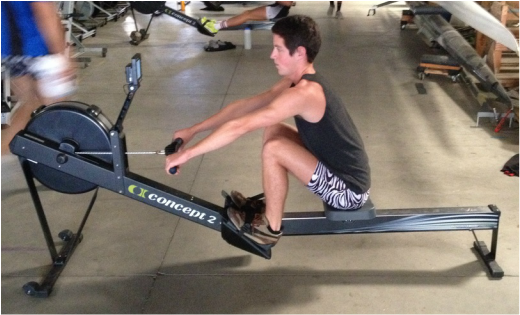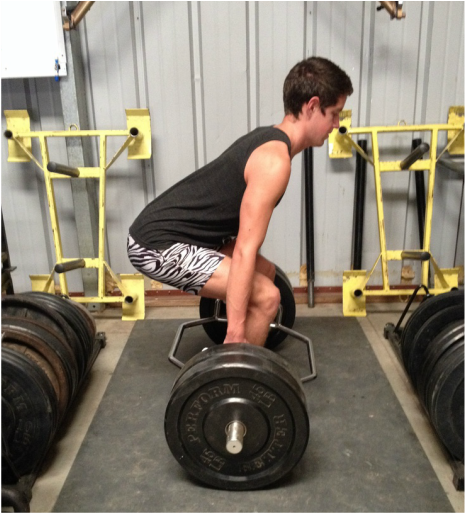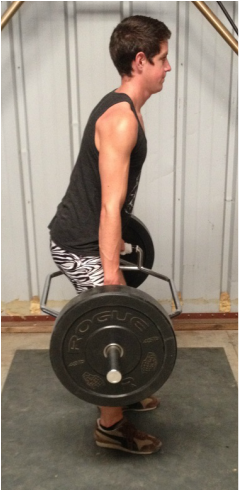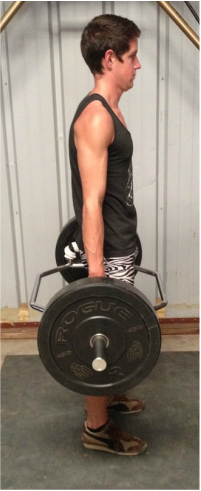|
There is no exercise that replicates the catch position of the stroke more so than the deadlift. There also isn't a lift that is more beneficial for rowers. Take a look at the two photos below. As you can see the main difference is one pull is coming from straight ahead and the other is coming from the ground. The only exercise that seems to replicate the stroke more closely is the erg. Benefits of the deadlift for rowers: 1) Improves Performance & Reduces Injury Potential It replicates the movement and stress of the stroke almost to the T. Due to this fact it encourages strength where it's needed in the stroke. The low body, the back, and the core are all developed in a connected fashion. All of this reduces the chance of an injury on the water and improves the performance of each drive. 2) Identifies limitations It identifies mobility or stability limitations, allowing you to work on them before they become a problem. If an athlete can't get down into a good starting position they will not be able to pick up the weight of each stroke well. What do they need? Hip mobility or core stability? The answer is probably a combination, but here are a couple of clues. Are they unable to get down into the starting position? Hip mobility is probably part of the problem. Are they rounding at the low back as they lift the weight? Stability is part of the problem. If you see either stop them right away, regress the movement and begin to coach them out of their limitation. 3) Reduces energy leaks It allows you to teach the athlete to create and maintain torque. If an athlete can't do this they are leaking energy. Leaked energy reduces performance, and is usually absorbed by joints, tendons, ligaments, and tissues (which eventually break down due to the stress). 4) Strengthens weak links It allows the athlete to complete hip extension, a movement that is far too rare in a rowers vocabulary. Glutes tend to be a weak point for rowers and because of this, and a few other factors, a whole chain of negative adaptations take place. This puts rowers in a very common overextended position which puts them at risk for a slough of injuries ranging from spinal injuries to rib stress fractures. 5) Serves as another coaching opportunity It's relate-able to the stroke and it allows the coach another method to teach the stroke. The more times you can explain the same motion in a different way the better. I have made many corrections on the deadlift that have found their way back to the water. A few things to consider before you start deadlifting; 1) Use kettlebell deadlifts to teach the movement first Placing the kettlebell between your ankles tends to force the athlete into the position you're looking for with minimal coaching. 2) Use a trapbar instead of a straight bar for strength development The trapbar is a safer option especially for beginners and taller athletes. The load is more centered toward the hips which helps reduce the sheering load on the spine. 3) Modify the lift for anyone who is having difficulty If an athlete cannot get down into a good starting position elevate the bar for them with a few plates. Identify their limitations and try to work them down to the floor overtime. These tend to be the same athletes who struggle to find full compression in the stroke. 4) Teach them how to create & maintain torque I don't let my athletes lift the weight until they follow 3 simple, but necessary steps:
If the athlete is successfully employing all 3 techniques they tend to perform the lift correctly. 5) Take it one rep at a time Conventional wisdom tells you to pick up the weight and rep out as many good reps as you can. I however, prefer singles for rowers. That means get into position, pick up the weight, put it down, and repeat. When singles aren't performed the first rep tends to always be rushed through and done incorrectly because it is the hardest rep to perform well. If the athlete can perform each single with great technique they have a better opportunity to transfer quality technique to lighter strokes. In the boat each stroke ranges from about 100-400 pounds of force. If the athlete doesn't know how to pickup the weight on land how are they going to perform 200 reps at 36-38 reps a minute? The athletes who create the most power on the water are the same athletes who can demonstrate flawless technique on the Trapbar Deadlift. Take your time, ease into the lift, and coach the heck out of it. You will not be wasting your time. Try having your team deadlift before throwing them on the ergs, I have noticed a direct transfer to the stroke in the form of better technical awareness and posture. Do not however, have them go heavy and then pound them with volume on the erg, that is asking for a back injury. As a side note: be aware of a common error that I see with all rowers when they are starting to learn the deadlift. They don't complete hip extension because it doesn't feel natural to them. Teach them to complete the lift by standing tall, squeezing the glutes and preparing for a punch in the gut. Strength Standards for High School Men: 1-2x Body weight for 5 reps Example: 150 pound athlete should be deadlifting between 150-300 pounds for 5 quality reps. Strength Standards for High School Women: .75-1.5x Body weight for 5 reps Example: 120 pound athlete should be deadlifting between 90-180 pounds for 5 reps. Remember, never sacrifice quality for a bigger weight.
3 Comments
11/7/2014 01:31:07 am
Would you like to write for our blog? We have never had strength and conditioning expertise on the site.
Reply
Andy
1/2/2020 10:05:51 am
Any advice for older rower as to how to integrate deadlifts w/ rowing, in terms of rest between the two, etc.
Reply
Hey Andy,
Reply
Leave a Reply. |
Author
Blake Gourley holds a Masters of Science in Sports Performance Training and has over 12+ years of experience working with rowers. Read more Categories
All
Archives
August 2023
|




 RSS Feed
RSS Feed